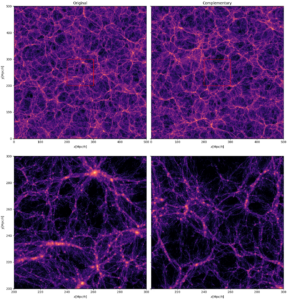Cosmological Simulation Datasets
Another important application of large numerical simulations is in cosmological N-body simulations, which model the evolution of the Milky Way or the entire Universe. SciServer hosts several of these simulations, offering unified access and collaborative visualization tools. The unique advantage of accessing these simulations through SciServer will be the ease with which they can be compared with real astronomical observations.
Each dataset is listed in an expandable section below. Expand it to learn what each dataset contains and how to access it.
> SMUDGE (Satellite Mergers Usher Disc Galaxy Evolution) +
What it is: The Satellite Mergers Usher Disc Galaxy Evolution (SMUDGE) simulations are a set of four high-resolution, N-body dynamical simulations of disk galaxies with each simulation containing over a billion particles. This suite includes two different models of isolated, disk galaxies and two versions in which these same disk galaxies experience a minor merger with a satellite galaxy.
How to access: This data volume contains about 154 TB of data, consisting of snapshots for each of the timesteps of the simulations. Each snapshot contains positions and velocities for the dark matter and ‘star’ particles, and the example Jupyter Notebook (available as part of the SMUDGE GitHub project and also stored in SMUDGE/data01_01, see the SMUDGE Dataset page for more detail) shows how to access both the individual timestep snapshots and trajectories (orbits) for individual ‘star’ particles over a given time period.
For more information, see the following references:
- For full details of the simulations and the primary citation, see Hunt et al. 2021
- Initial conditions for the host were taken from Widrow & Dubinski 2005, and generated using
Galactics(Kuijken & Dubinski 1995) - The satellite is the L2 model from Laporte et al. (2018)
- The simulations were run with the GPU accelerated N-body tree code
Bonsai(Bédorf et al. 2012)
For details about the data, see the SMUDGE Dataset page.
> Indra Cosmological Simulations databases +
What it is: Indra is a suite of large-volume cosmological N-body simulations. Each of the 384 simulations is computed with the same cosmological parameters and different initial phases, providing excellent statistics of the large-scale features of the distribution of dark matter. The independent volumes have 10243 dark matter particles in a box of length 1 Gpc/h, and are all accessible through SciServer Compute containers to all users who join the Cosmology science domain. A full description of the Indra suite of simulations can be found in a paper by Falck, et al (2021).
How to access: Indra data are accessed with the indra-tools python package pre-installed on the Computational Simulations compute image. The indra-tools git repository contains example notebooks showing how to read the binary data, query the halo database tables, compute density fields, etc.
Use of the Indra dataset is open and available to anyone. We ask that scientific publications that make use of Indra cite the Falck, et al (2021) data release paper.
> MillenniumG4 Complementary Cosmological Simulations +
What it is: MillenniumG4 and MillenniumG4_Complementary are a matching pair of cosmological N-body simulations.
How to access: Join the Cosmological Simulations science domain from the SciServer Dashboard.
To minimize the effects of cosmic variance, the averaged initial power spectrum of the pair was set to exactly match the cosmic average power spectrum. These simulations were started from inverted phases relative to each other. As a consequence, the structure formation is inverted in the pair: a region that collapses to a halo in the original Millennium run tends to expand into a void in the corresponding complementary pair and vice versa. Since the amplitudes are also compensated with the complementary pair, the average statistical quantities of a pair of such simulations are expected to remain consistent with the non-linear state-of-the-art estimation methods even at late times. This makes this pair ideal for estimating the effects of the cosmic variance in the original Millennium simulation.
This data volume contains two simulations:
- MillenniumG4 is a re-simulation of the original Millennium Simulation. It has the same cosmological parameters, resolution, linear size, softening, integration accuracy, initial phases and amplitudes as the original simulation, but it was run with the more recent and publicly available GADGET-4 simulation code.
- MillenniumG4_Complementary is the complementary simulation of the MillenniumG4. This simulation has the same cosmological parameters, resolution, linear size, softening and integration accuracy as the MillenniumG4 simulation, but it has modified initial amplitudes with inverted phases. It was run with GAGDET-4.
The following datasets are available for each simulation:
- 64 snapshots of dark matter particle coordinates and velocities
- 64 power spectra of each particle snapshot
- 64 snapshots of dark matter FOF halo and SUBFIND subhalo catalogues
- 64 reconstructed NGP density fields on a 256^3 grid
While by itself the original simulation was not large enough to resolve the baryonic wiggles in the power spectrum due to the sample variance at the low-k modes, the average power spectrum of the original and complementary Millennium simulation are able to directly follow the evolution of the baryon acoustic oscillation features.
If you plan to publish an academic paper using this data volume, please consider citing the Rácz, et al (2022) publication.

